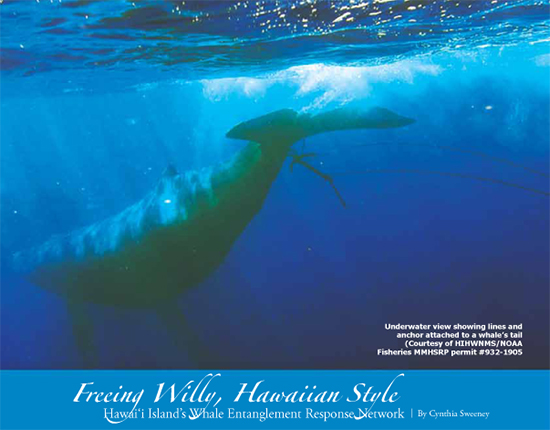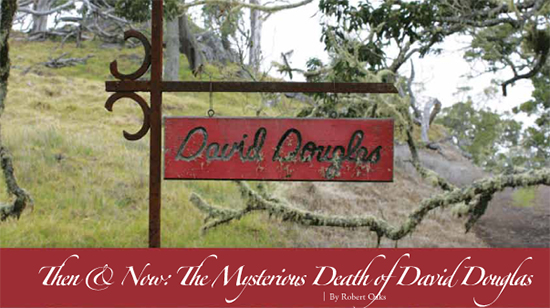
Freeing Willy, Hawaiian Style: Hawai‘i Island’s Whale Entanglement Response Network
By Cynthia Sweeney
More than 10,000 humpback whales migrate to the Hawaiian Islands each year, mostly from Alaska, to give birth. And it is estimated that 30 percent of those whales, adults as well as calves—have been entangled in fishing lines at some point.
Whales, along with other marine animals, are susceptible to many natural dangers including orcas and sharks. Humans inadvertently contribute considerably with pollution, boat collisions, hunting and fishing lines, and random debris like crab pots or trap cages. Entangled whales often swim here trailing their fishing lines. The longest recorded distance a whale carried gear was more than 2,450 nautical miles from Alaska to Maui.
Only a handful of people in the world have the training and the mental and physical stamina required to go eyeball to grapefruit-sized eyeball with an entangled, 35-ton humpback whale. Justin Viezbicke is one of them.
Each year, Justin, the Hawai‘i Island Programs Coordinator with the National Oceanic and Atmospheric Administration (NOAA) and his network of community volunteers disentangle whales caught in fishing lines and other life-threatening hazards offshore of Hawai‘i Island.
Since the Hawai‘i Islands Large Whale Entanglement Response Network was founded in 2002, the Network has mounted over 121 on-water or in-air responses, freeing 16 whales with more than 6,700 feet of entangled line removed.
Over the last several years the number of entanglements involving local pot gear has increased. Statewide, the Response Network has grown to more than 230 mostly volunteer members who have received various levels of training in order to support large whale response efforts.
“A huge part of the entanglement network is the community. The whale tour boats and fishermen are pretty aware of what to look for,” Justin said.
The Humpback Whale National Marine Sanctuary on Hawai‘i Island spans from Keāhole point, near the Kona airport to Upolu point in North Kohala. Although whales can be seen all around the island, this area is identified with the highest density of these 35-45 ton, endangered marine animals.
Humpback whales may travel 3,000 miles from Alaska to Hawai‘i one year and then to Japan or Mexico the next. “Hawai‘i is the main thoroughfare, and they go other places,” Justin explains. “The interesting part is we don’t know for sure how they navigate. Perhaps it is by sound or magnetic fields. It’s something we just don’t know.”
The whales swim around the Hawaiian Islands with no discernable pattern. Researchers like Justin track whales by taking pictures of their tail flukes. At 15-feet wide, the markings on a whale’s fluke are as unique as a fingerprint.
Justin and his assistant, Kanani Frazier, run a small office at the very end of the Natural Energy Lab park just south of the Kona Airport. The office is cluttered with an inflatable raft, boat motor, bags of gear, specially made knives for cutting the entangled lines, satellite buoys, and stuffed animals—props for educational talks.
When a call comes in from someone who has spotted a whale in trouble, it takes Justin about two hours to mobilize, loading up his truck with gear and driving to Honokōhau harbor. Since there is no response boat on this island, he relies on community support.
“Without resources (like a boat) we rely on the community of ocean users, volunteers, all these different entities putting in their piece to make this work,” Justin emphasizes.
Susan Rickards, with the Hawai‘i Marine Mammal Consortium (HMMC), plays an integral role in the entanglement response team. She is a researcher with about ten years experience on the waters collecting data and being around marine animals. She has also taken workshops with the entanglement network. Based in Kawaihae, she is on-call and frequently volunteers to drive HMMC’s 17-foot Boston Whaler. HMMC is a non-profit organization with federal and state permits to approach a whale within the 100-yard limit and is also involved in tracking and tagging.
“We have our own gear and if need be we can assist to attach a satellite buoy with transmitters to trail the animal,” Susan replied, adding there is a lot of cooperation from the tourism industry. Helicopter operators and whale-watch boats will wait by the entangled animal until Justin and company arrive on the scene.
Entanglement rescues are dangerous on many levels. The operation requires adherence to strict protocol, and the safety of the crew is the first priority.
“People want to do something, yet they need to let us come and deal with it,” Justin emphasizes. “It can be extremely dangerous and these huge animals can do a lot of damage.”
Before any action is taken, Justin assesses the whale’s predicament.
“The biggest part is evaluation. First we assess the situation for what’s safe. Is it life threatening for us? We want to know what’s going on before we do anything at all,” he says. “We document everything and evaluate everything we do.”
If a whale has been entangled for some time, he may be quite injured, tired, and moving slowly. If a whale has recently been entangled, he’s most likely still active and reactionary to changes is his immediate environment. If a calf is entangled, the protective mother will be somewhere nearby.
Sometimes the problem is actually locating the whale. An entangled whale can be spotted again and again, and yet by the time the team gets to the location the whale is gone—on the move and diving deep.
If Justin determines the situation is safe enough that the whale can be disentangled, he attaches a satellite tracking buoy, which looks like a hard, plastic beach ball, to the entangled material. Hopefully, it will remain attached and continue to work. He then heads back to shore and calls for back-up.
Ed Lyman is the Resource Protection Manager, Large Whale Entanglement Response Coordinator with NOAA, and is based on O‘ahu. Originally from the East Coast, Ed flies to Mexico, Alaska, and up and down the West Coast training and providing education in Large Whale Entanglement.
“It’s really the efforts of the on-water community that makes the difference in whether an entangled whale is ultimately saved,” says Ed, who flies over from O‘ahu to join the crew. “And the information we gain is used to reduce the entanglement threat to these magnificent animals in the future.”
All Network efforts involving close approach to large whales are authorized and permitted under NOAA Fisheries’ Marine Mammal Health and Stranding Response Program. Justin has over eight years of whale entanglement training and follows strict NOAA protocol. He also goes to O‘ahu each year for pre-season training where the regimen mostly involves preparedness for worst case scenarios, such as a person falling overboard, getting injured, or if the raft flips over.
The work has other unexpected aspects as well.
“Everybody thinks it’s cool to be out there with the whales,” Justin said. “It is, until you get snot [from a blowhole] blown all over you. It’s nasty, it smells, and it’s gross.”
Disentangling a whale requires a high level of physical and mental stamina. Members of the entanglement network put in long hours on the water. Depending on how entangled the whale is, and if the weather is cooperating, they could spend up to eight hours bouncing around in the dingy. Mentally, the rescuers in a high state of alertness and strive to keep their emotions in check.
“You have to keep emotions out of it,” Ed explains adding “Even though you do your best, you get home and [the emotion] hits you.”
The most difficult situation Ed has experienced was off the coast of North Carolina, when his team spent a month trying to free an entangled female Sei Whale. Then Hurricane Floyd hit and they had to cease operations. “That hit us hard. There are only 300 of the Sei left, and she was a female. The energy [of that loss] hit us hard,” he said.
Sometimes during the evaluation, it is determined that a whale is too far gone to risk the network’s safety in saving it. “It’s tough to make that decision,” Justin admits. “We have to ask ourselves ‘why put people in the line of fire when there is no hope?’ We need a safe environment to work in.”
Specially made knives are used to actually cut the lines in the right places. V-shaped with serrated edges, they are attached to long poles.
“You never want to get into the water [around an entangled whale]. It’s very unsafe. You could get pulled under or caught up in the lines,” Justin says.
The lines are strategically cut. If the whale is anchored down by a line, that is the last line to be cut because as soon as the whale is freed, it bolts. Although the whales don’t look back and wave their fin in thanks like in the movies, Justin is moved.
“It’s definitely very exhilarating—my favorite part of the job,” he says.
Susan concurs.
“You can’t let emotion or ego get involved. You have to trust the other people you’re with immensely. It’s very unglamorous, and it’s a job first,” she emphasized. “But it’s awesome by any context to be out there with a 40-foot whale, and everything that goes along with that. Obviously we’re human and can’t escape how awe inspiring it is to free an animal like this.”
Justin grew up in Colorado, far from any large body of water. Yet he knew from a young age that he wanted to work with marine animals, which frequently found their way into his science projects. He went on to earn degrees in marine biology and environmental ecology.
Justin’s job is part C.S.I., part Jacques Cousteau. Tracing the entangling menace back to where it came from is possible because the fishing communities are small and tight. Telltale signs like certain kinds of knots and gear are specific to certain areas. Entangled fishing gear, marine debris and mooring gear has been traced back to the Pribilof Islands, the Aleutians, and Southeast Alaska. In fact, last year, fishing line was traced back to a fisherman in Wrangell, Alaska. That line now hangs on the fisherman’s garage door.
“Losing gear is expensive and entangling whales is not something the fishermen want to happen,” Justin says.
While eight or ten entanglements per 10,000 whales may not seem significant, indications from scaring and other wounds suggest that about 30 percent of the population has been in trouble with entanglement at one time or another. Thus, a large part of the entanglement mission is about education and prevention.
“It’s not a waste of time to save one animal. We are learning a lot each time we go out and it’s helpful to the species as a whole,” Susan said.
The law states that people and boats must maintain a 100-yard distance from humpback whales. Violators are prosecuted and fines vary according to a violator’s intention. A couple of years ago a paddle boarder on Maui was fined $600, although fines can exceed thousands of dollars.
NOAA is mostly an educational organization which also enforces federal and state regulations as they apply to the Endangered Species Act. Working with the Coast Guard and DOCARE, NOAA officers patrol the waters within the Humpback Whale Sanctuary for one week each month during the whale season.
“We want people to be aware that things we do in the ocean have an effect,” Justin points out. “We want people to be aware that things we do in the ocean have repercussions. We’re looking for a win-win situation, finding a way that humans and whales can coexist.”
For more information: HawaiiHumpbackWhale.noaa.gov
The whale entanglement hotline: 888.256.9840
In Kailua-Kona, Justin Viezbicke: 808.327.3697
To volunteer for the annual whale count: 1.888.55.whale (94253) ext. 253
Shoreline Whale Watches at Pu‘ukohala Heiau National Historic Visitor’s Center in Kawaihae are every Friday from 9–11 am through March, 808.882.7218.
Justin will be speaking at the third annual Ocean Film Festival in January: WaimeaOceanFilm.org
Contact writer Cynthia Sweeney: sweeneywrites AT yahoo.com


